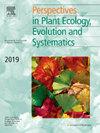Reproductive biology and pollinators of Musschia wollastonii Lowe (Campanulaceae)
IF 2.9
3区 环境科学与生态学
Q1 ECOLOGY
Perspectives in Plant Ecology Evolution and Systematics
Pub Date : 2025-03-16
DOI:10.1016/j.ppees.2025.125866
引用次数: 0
Abstract
Understanding the reproductive biology of plants is particularly relevant for the conservation of rare, threatened or endemic plants. Musschia wollastonii Lowe is a rare, monocarpic, neoendemic species of the island of Madeira with a complex reproductive biology including outcrossing and selfing. However, nothing is known about the extent of the dependence of the species on pollinators for its reproduction, a possible incompatibility system, or the extent of selfing. We found that M. wollastonii is self-compatible and shows spontaneous but delayed selfing. Outcrossing is promoted by protandry, weak dichogamy, and a mechanism of secondary pollen presentation on the abaxial surface of the stigmatic lobes. The four-month flowering period and large inflorescence, traits that promote cross-pollination, suggest a mixed mating system. Observed flower visitors were insects from the Syrphidae and Drosophilae (both Diptera), Nymphalidae (Lepidoptera) and Vespidae (Hymenoptera) families. All insect flower visitors observed were pollen thieves and had thus potentially a negative impact on reproductive success, but a positive role as pollinators is suggested for syrphids and the butterfly Pararge xiphia (Nymphalidae). Although reported by other authors, no bird visitations were recorded in the studied habitat.
野鼠的生殖生物学及传粉媒介
了解植物的生殖生物学对保护珍稀、濒危或特有植物尤为重要。沃拉斯顿Musschia wollastonii Lowe是马德拉岛的一种罕见的单生新特有物种,具有复杂的生殖生物学,包括异交和自交。然而,对于该物种在繁殖过程中对传粉者的依赖程度、可能的不相容系统或自交程度,人们一无所知。我们发现wollastonii具有自亲和性,表现出自发但延迟的自交。异交主要由原雄体、弱二偶性和次生花粉在柱头裂片背面的呈现机制促进。四个月的花期和大的花序,促进异花授粉的特征,表明一个混合的交配系统。访花昆虫主要为双翅目蚜蝇科和果蝇科、鳞翅目蚜蝇科和膜翅目寄生蜂科。观察到的访花昆虫都是花粉窃盗,因此对繁殖成功率有潜在的负面影响,但对蚜蝇和蛱蝶具有积极的传粉作用。虽然有其他作者的报道,但在研究的栖息地没有鸟类来访的记录。
本文章由计算机程序翻译,如有差异,请以英文原文为准。
求助全文
约1分钟内获得全文
求助全文
来源期刊
CiteScore
6.50
自引率
0.00%
发文量
28
审稿时长
67 days
期刊介绍:
Perspectives in Plant Ecology, Evolution and Systematics (PPEES) publishes outstanding and thought-provoking articles of general interest to an international readership in the fields of plant ecology, evolution and systematics. Of particular interest are longer, in-depth articles that provide a broad understanding of key topics in the field. There are six issues per year.
The following types of article will be considered:
Full length reviews
Essay reviews
Longer research articles
Meta-analyses
Foundational methodological or empirical papers from large consortia or long-term ecological research sites (LTER).

 求助内容:
求助内容: 应助结果提醒方式:
应助结果提醒方式:


